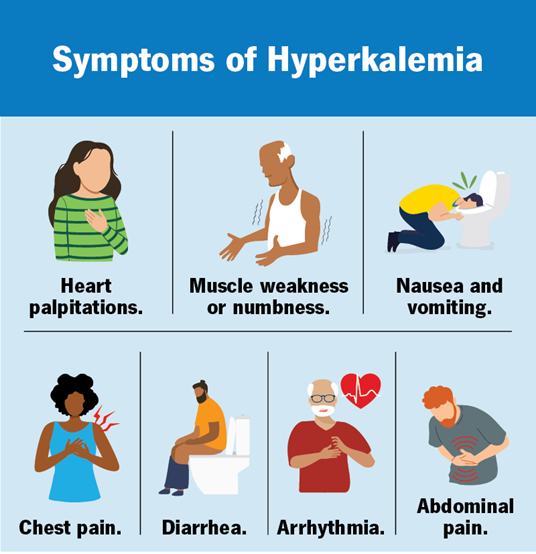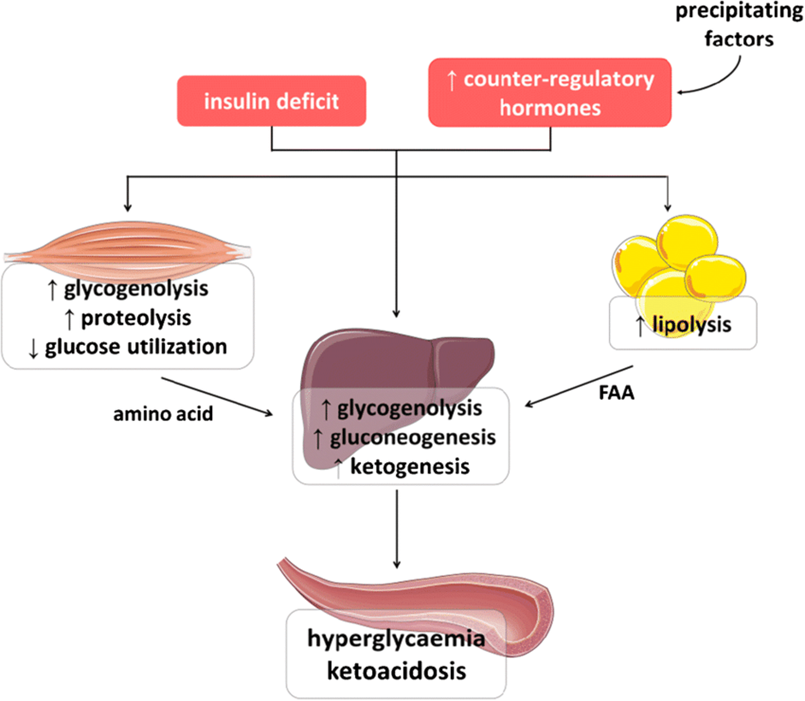The nurse is caring for a child with acute renal failure. Which clinical manifestation should the nurse recognize as a sign of hyperkalemia?
Cardiac arrhythmia
Seizure
Dyspnea
Oliguria
The Correct Answer is A
Choice A reason:
Cardiac arrhythmia is a primary clinical manifestation of hyperkalemia. Hyperkalemia, defined as an elevated level of potassium in the blood, can significantly affect the electrical activity of the heart. This can lead to various types of arrhythmias, including bradycardia, ventricular tachycardia, and even cardiac arrest1. The presence of arrhythmias is a critical indicator of hyperkalemia and requires immediate medical attention to prevent life-threatening complications.

Choice B reason:
Seizures are not typically associated with hyperkalemia2. While severe electrolyte imbalances can potentially lead to neurological symptoms, seizures are more commonly linked to conditions such as hyponatremia (low sodium levels) or hypocalcemia (low calcium levels). Therefore, seizures are not a primary sign of hyperkalemia.
Choice C reason:
Dyspnea, or difficulty breathing, can occur in various medical conditions, including heart failure and respiratory disorders. While hyperkalemia can lead to muscle weakness and fatigue, which might indirectly affect breathing, dyspnea is not a primary clinical manifestation of hyperkalemia. The main concern with hyperkalemia is its effect on cardiac function.
Choice D reason:
Oliguria, or reduced urine output, is a symptom of acute renal failure but not specifically indicative of hyperkalemia. While acute renal failure can lead to hyperkalemia due to the kidneys’ inability to excrete potassium, oliguria itself is not a direct sign of hyperkalemia. The focus should be on the cardiac effects of elevated potassium levels
Nursing Test Bank
Naxlex Comprehensive Predictor Exams
Related Questions
Correct Answer is A
Explanation
Choice A reason:
Weight loss despite increased eating is a classic symptom of type 1 diabetes mellitus in children. This occurs because the body is unable to use glucose for energy due to a lack of insulin. As a result, the body starts breaking down fat and muscle for energy, leading to weight loss even though the child may have an increased appetite.
Choice B Reason:
Pale, moist skin is not typically associated with type 1 diabetes mellitus. This symptom is more commonly related to conditions such as anemia or infections. In type 1 diabetes, the skin may actually appear dry due to dehydration caused by high blood sugar levels.
Choice C Reason:
Weight gain and fluid overload are not characteristic of type 1 diabetes mellitus. In fact, children with type 1 diabetes often experience weight loss. Fluid overload is more commonly seen in conditions such as heart failure or kidney disease.
Choice D Reason:
Poor sleep with frequent awakening is not a specific symptom of type 1 diabetes mellitus. While children with diabetes may experience nocturia (frequent urination at night) due to high blood sugar levels, this is not the primary clinical manifestation. The main symptoms are related to hyperglycemia and the body’s inability to use glucose for energy.
Correct Answer is C
Explanation
Choice A reason:
Extracellular hyperglycemia refers to high blood sugar levels outside the cells. While hyperglycemia is a common feature of diabetic ketoacidosis (DKA), it is not the direct cause of the condition. DKA occurs when the body cannot use glucose for energy due to a lack of insulin, leading to the breakdown of fat and protein for energy, which produces ketones and causes acidosis.
Choice B Reason:
Hypoglycemia, or low blood sugar, is not associated with diabetic ketoacidosis. In fact, DKA is characterized by high blood sugar levels. Hypoglycemia is a separate condition that can occur in individuals with diabetes, particularly if they take too much insulin or skip meals.
Choice C Reason:
The use of fat and protein as an energy source is the primary mechanism behind diabetic ketoacidosis. When insulin is deficient, the body cannot utilize glucose for energy. As a result, it breaks down fat and protein to produce energy. This process generates ketones, which are acidic and lead to the development of ketoacidosis.

Choice D Reason:
Increased cellular metabolism of glucose is not related to diabetic ketoacidosis. In DKA, the problem is that cells cannot use glucose effectively due to a lack of insulin. Instead, the body resorts to breaking down fat and protein for energy, leading to the production of ketones and acidosis.
Whether you are a student looking to ace your exams or a practicing nurse seeking to enhance your expertise , our nursing education contents will empower you with the confidence and competence to make a difference in the lives of patients and become a respected leader in the healthcare field.
Visit Naxlex, invest in your future and unlock endless possibilities with our unparalleled nursing education contents today
Report Wrong Answer on the Current Question
Do you disagree with the answer? If yes, what is your expected answer? Explain.
Kindly be descriptive with the issue you are facing.
